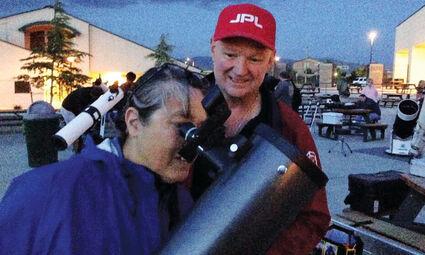Airport star party is back, Sep. 11
August 14, 2021

Lauren Hollen
Star parties are a great place to learn about the sky, the hardware and the people who enjoy them.
The COVID pandemic has shut down our community star parties for far too long. At last, it's time to gather 'round the telescopes once again! This year we have all of the planets in our evening sky; some near the setting sun, others rising as it gets dark.
While Mars, Mercury and blazing Venus set close to the setting sun, the other four planets pop out across the darkening evening sky. Jupiter and its four big moons will be visible early along with glorious Saturn, with its rings open a healthy 21º. Uranus and Neptune will also climb above the glare as the evening cools.
On Sep. 11, the public is welcome from 6:30-10 p.m., with dark occurring around 8 p.m. at Aviator Park. The park is located at the Tehachapi Municipal Airport, 314 N Hayes St., Tehachapi.
Astronomers love to share their telescopes, and some of these will be quite large and/or sophisticated. However, even a small telescope can put on a fine show in the right hands. Star parties are a great opportunity to learn about the sky, telescopes, binoculars and especially to share our wonder of the limitless vistas. If you have a telescope or binoculars and aren't quite sure how to use them, bring them down to Aviator Park; there will be plenty of willing astronomers happy to show off their knowledge!
This will be an evening with a first-quarter moon, which also provides a stunning target for the young-at-heart astronomer. We'll continue to celebrate the 50th anniversary of Project Apollo. Fifty years ago, Apollo 15, with its new Lunar Rover, successfully returned with 170 pounds of moon rocks from Hadley Rille, including rocks older than any ever found on Earth. Apollo 16 would depart in April for Descartes Crater in the rugged south-central highlands.
This event is sponsored by the City of Tehachapi with the support of your local NASA/JPL Solar System Ambassadors and the Tehachapi Society of Pilots.
Gearing up
I have often been asked how to get started in astronomy. Invariably, people want to start talking about telescopes – what's the best kind, who makes the best, how much do they cost? But, the fact is that buying a telescope isn't the place to start as a budding astronomer at all! The first thing to do is to go down to a newsstand and pick up a copy of Astronomy or Sky & Telescope magazine. In there you'll find a star chart and plenty of objects highlighted for the month. You'll also find a wealth of information in articles and ads with links to endless streams of knowledge.
The next thing to do is to buy a good pair of binoculars. Telescopes have greater light-gathering ability and see deeper into the universe. However, binoculars have some important advantages, including:
• Affordability – I bought a pair of 7×50 binoculars at Rite-Aid for $10!
• Portability – No telescope is as "grab-and-go" as binoculars.
• Ease of Use – Although one should be shown how to properly use binoculars (lectures will be provided at the star party!), they're easier to master than most telescopes.
• Versatility – Binoculars lend themselves to more uses than a telescope, including watching aircraft, rockets and other wildlife.
• "Two eyes are better than one," to quote Astronomy magazines' Phil Harrington. Both eyes working together generate a more vivid image for the brain, even without any true depth perception.
• A wider field of view allows you to take in the huge expanses of stars and dust clouds.
Binoculars are described by two numbers separated by a multiplication sign (×). The first number describes the "magnification power," or how much larger the image appears. The second number describes the diameter of the big objective lenses in the front (expressed in millimeters); the larger the lens, the more light it can gather. Thus, "7×50" binoculars magnify an object seven times, and have 50 mm objective lenses. (For the technical among you, our pupils are about 10 mm in diameter. Squaring the ratio of the objective lens and pupil diameters gives us the increase in light gathering power; in this case, 25.)
What kind is best for astronomy? Why, the biggest ones you can get, of course! However, if they are too big to hold steady by hand, you'll need a sturdy tripod. The conventional wisdom is that 7×50s are the largest that can be held steady by hand. Today, with newer plastic lenses and prisms that are as good as glass, and strong plastics replacing metal, many 10×60s can be handheld quite well.
A word of caution about quality: all binoculars are not created equal. If you buy a $10 pair, carefully inspect them before leaving the store. In particular, make sure that both of the oculars point in the same direction! Ask if you can take them outside. Focus on a distant object and make sure you comfortably see only one image. If there is any tendency toward double images, try another pair.
You'll recall that I said that the best binoculars are the biggest that you can hand-hold. To that end, a truly amazing innovation is the image stabilized binoculars. Point my big 15×70s at a target, press a button, and the image freezes (or nearly so) even though your hand is still quaking! They run on only two AA batteries. The downside is that prices start well above a grand. However, I bought a used a pair for $750 and have been delighted with them. I use them far more than my telescope.
You could easily spend a good year getting thoroughly familiar with the sky using only your binoculars. By that time, you'll be ready to start focusing on your first telescope. Imagine what you'll have learned in that time!




